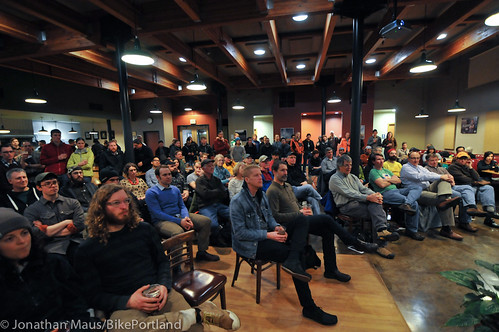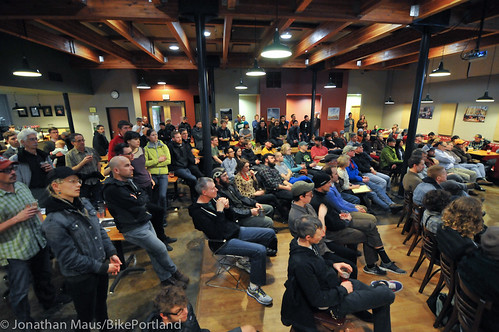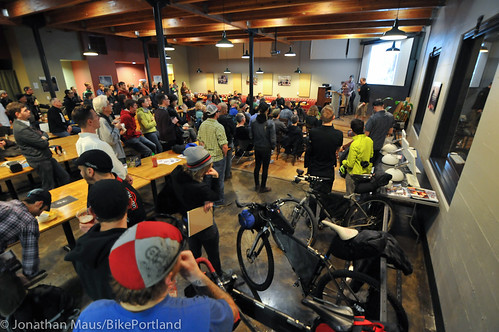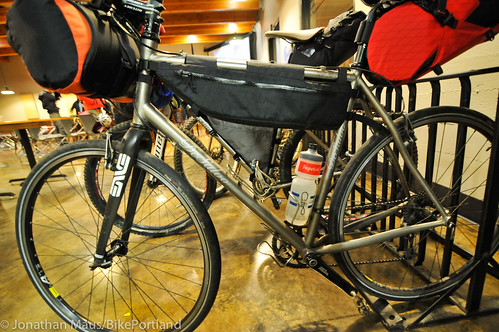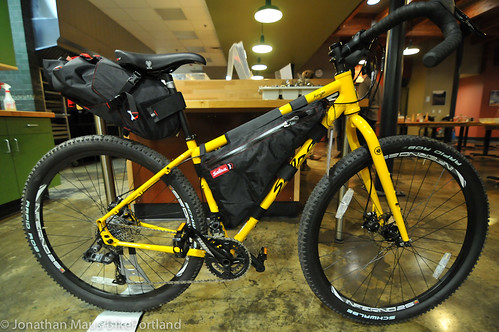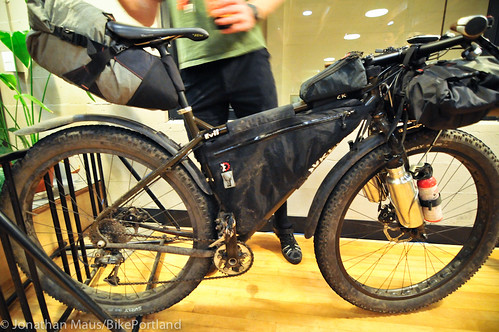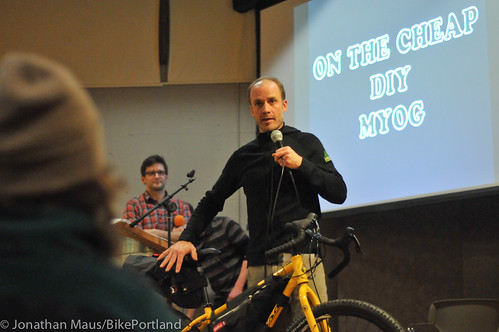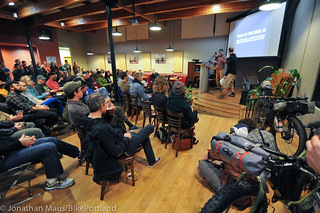
a trio of experienced bike adventurers.
(Photos by J. Maus/BikePortland)
A much larger than expected turnout at last night’s Bikepacking 101 Seminar confirmed that interest in backroads and adventure bicycling is at an all-time high. Either that, or people just jumped at the chance for some great free beer, catch up with friends (and make new ones) and a peek inside the headquarters of Chris King Precision Components.
In all seriousness, the 200+ people that packed the King Cafe was yet another reminder that we’ve hit a tipping point in this type of riding. From “gravel grinding” on beefed up road bikes to multi-day trips on fully decked-out fat-bikes, it seems like everyone is getting excited for two-wheeled adventures these days.
How big was the crowd? It took me a few shots with a wide angle to get it all…
Both the interest in this type of riding and the big crowd last night was due in large part to the three guys who hosted the event: Nick Sande, Donnie Kolb, and Alan Gunn. Each one of them has explored an enviable amount of Oregon’s backroads by bike and they each share a sense of enthusiasm that manifests itself in a strong desire to share what they know and get more people out there with them.
Nick (a bike industry veteran with former stints at Surly and who know works for Cielo), Donnie (an attorney), and Alan (a mapping and GIS specialist for Metro) presented a lot of information last night on a huge array of topics. We heard advice and tips about gear, bike set-up, route planning, remote survival techniques, how to have good interactions with people you come across in remote areas, and more.
Below are a some of best tips I heard:
Bikes:
- Almost any bike can be used for bikepacking. Road bike, mountain bike, cross bike, hybrid… Just ride what you have!
- Put another way by Donnie: “Take what you have, strap some shit to it, and go ride.”
Here are a few of the bikes on display last night:
Packing:
- Keep all your gear “light and tight.”
- The space an item takes up in your bag is more important than weight.
- Ultralight backpacking gear won’t hold up to rigors of bike trips.
- Frame/saddle/handlebar bags are preferred by these guys over the more traditional racks/panniers set up.
- Buy extra straps for cinching things down.
- Stuff sacks and dry bags can be cheaper alternatives to bike-specific bags.
Gear:
- Two bag makers highly recommended by Nick are Revelate and Porcelain Rocket.
- Don’t skimp on tire size. 2.0-inch and larger seemed to be the preferred set-up for loaded, multi-day off-road adventures.
- In Portland, Andy & Bax was called a “superstore for bikecamping” by Alan.
Routes, Mapping and Navigation:
- Roads seen on Google Maps often don’t exist or don’t go through.
- Make sure your maps are updated recently. Logging roads in the Pacific Northwest can grow over quickly, sometimes in 10 years or less.
- Good sites to get routes: While Out Riding, Gypsy By Trade, and Swerving Excursions.
- Buy and use real maps. Then print out the sections for your trip.
- GPS devices can be unreliable.
- Bike-specific GPS devices are not good for navigation. Use the models made for hiking.
- Smartphone map apps by Gaia and Benchmark are excellent.
- Printed maps from Benchmark are the best.
- You can download free, updated maps from USGS.gov.
- Make your route interesting by connecting things like epic roads, hot springs, geological formations, cool towns, and so on.
Planning:
- Nick swears by using a spreadsheet to list all your gear and to make notes about how/if it works.
- Keep a notebook during your ride and write down what works and what doesn’t (then add it to your spreadsheet).
- Good average mileage on a loaded, off-road trip is 35-40 miles per day.
- “Shakedown” rides are key. Test your set-up by riding through the neighborhood.
Water:
- Camp near a water source.
- Filter or purify everything before drinking.
- Know your route: One portion of the Oregon Outback goes 80 miles without any water.
- Do research before your trip to find where the services are, then print out the information and take it with you.
Human interaction:
- Wave and say hi to everyone you come across.
- People will be surprised to see you.
- Most importantly, don’t wear spandex! Especially in remote and rural areas. “No one wants to talk to you if you’re dressed like that,” Donnie warned.
Random:
- There’s no shame in walking.
- Make sure your bike shoes are comfortable because you never know when you’ll get stranded and/or have to walk several miles.
- To be ready for anything, don’t just train by riding, keep your core and arms strong too.
- Learn to repair flats, tire gashes, broken spokes, derailleur adjustments, and broken chains.
- “Knowledge weighs nothing.”
- Strap a pair of Crocs to your bike.
- Don’t wear a backpack.
- Solar power isn’t effective for recharging devices.
- The cool bikepackers these days are using dynamo hubs with USB outlets built in like the Luxos U.
Three recommended routes:
- Nick: Scappoose to Vernonia via the Crown Zellerbach Trail.
- Alan: The Deschutes Rail Trail
- Donnie: Around Mt. Hood
I’m excited to see what this adventure riding enthusiasm leads to next. And I’ve also got to start packing for the Oregon Outback in May!
For more info, check out the gorgeous Bunyan Velo magazine and stay tuned to Donnie’s website, VeloDirt, for more resources and great local routes.

